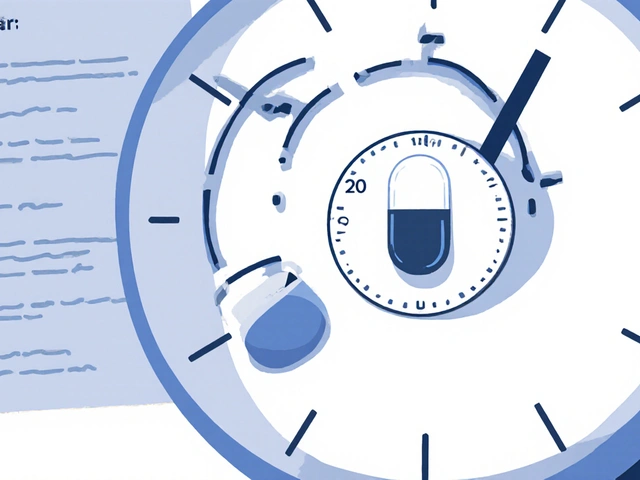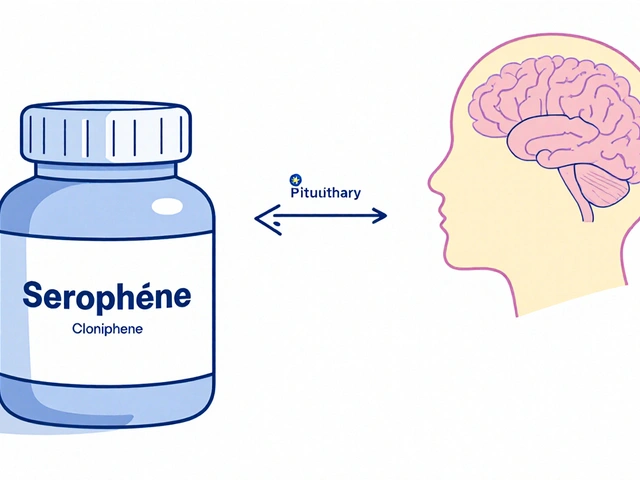TL;DR
- Tenormin is the brand name for atenolol, a beta‑blocker that lowers blood pressure and heart rate.
- It’s prescribed for hypertension, angina, arrhythmias, and after heart attacks.
- Typical adult dose starts at 25‑50mg once daily, max 100mg; adjust for kidney function.
- Common side effects: fatigue, cold hands/feet, dizziness; serious ones are rare but include low heart rate and bronchospasm.
- Don’t stop abruptly - taper under doctor guidance, and tell your pharmacist about other meds.
What Is Tenormin?
Tenormin is the trade name for the drug atenolol, a selective beta‑1 adrenergic blocker. It belongs to the beta‑blocker family, which means it blocks the action of adrenaline on the heart. By doing so, it slows the heart rate, reduces the force of each beat, and dilates blood vessels, resulting in lower blood pressure.
In the UK, Tenormin is a Prescription‑Only Medicine (POM) and is usually prescribed by GPs, cardiologists, or hypertension specialists. It’s available in 25mg and 50mg tablets, and sometimes in a 100mg strength for resistant cases.
How Does Tenormin Work?
When you take Tenormin, atenolol selectively binds to beta‑1 receptors located mainly in the heart and kidneys. This blocks the usual response to norepinephrine and epinephrine (the “fight‑or‑flight” hormones). The result is three key actions:
- Reduced heart rate (negative chronotropy): the heart beats slower, cutting down the amount of work it has to do.
- Decreased contractility (negative inotropy): each beat is less forceful, lowering cardiac output.
- Lowered renin release: the kidneys release less renin, which eventually reduces the production of angiotensin II - a molecule that makes blood vessels narrow.
Combined, these effects bring down systolic and diastolic blood pressure, ease chest pain in angina, and help stabilize abnormal heart rhythms.
Who Should Take Tenormin?
Tenormin is a go‑to option for several cardiovascular conditions:
- Hypertension: especially when patients also have a history of heart disease.
- Angina pectoris: helps reduce the frequency and severity of chest pain.
- Post‑myocardial infarction: lowers the risk of a second heart attack.
- Arrhythmias: such as atrial fibrillation or supraventricular tachycardia.
It’s generally avoided or used with caution in people with asthma, chronic obstructive pulmonary disease (COPD), severe bradycardia (heart rate<50bpm), or certain types of heart block. Kidney impairment also calls for dose adjustment because atenolol is excreted unchanged in the urine.

Dosage, Administration & Practical Tips
Prescribers aim for the lowest effective dose. Below is a typical dosing schedule for adults:
- Initial dose: 25mg or 50mg once daily.
- Usual maintenance: 50mg-100mg once daily, taken at the same time each day.
- Kidney dysfunction: start at 25mg and consider a maximum of 50mg.
- Elderly patients: often start low (25mg) and titrate slowly.
Take Tenormin with a glass of water. It can be taken with or without food, but if you notice stomach upset, a light snack may help. Consistency matters-missing a dose can cause rebound hypertension or heart rate spikes.
Never stop Tenormin abruptly. A sudden withdrawal can trigger tachycardia, chest pain, or severe hypertension. If you need to discontinue, ask your doctor for a tapering plan, typically reducing the dose by 25mg every 1-2 weeks.
Side Effects, Precautions & Interactions
Like any medication, Tenormin has a side‑effect profile. Most patients experience mild effects that settle after the first few weeks. Below is a quick reference table of the most common and serious adverse events.
| Side Effect | Frequency | Typical Management |
|---|---|---|
| Fatigue / tiredness | Common (≥10%) | Monitor energy levels; may lessen as body adjusts. |
| Cold extremities (hands/feet) | Common (≥10%) | Wear warm clothing; check circulation if severe. |
| Dizziness / light‑headedness | Common (≥10%) | Rise slowly from sitting/lying; stay hydrated. |
| Bradycardia (HR<50bpm) | Uncommon (1‑10%) | Doctor may reduce dose or switch medication. |
| Bronchospasm / wheezing | Rare (<1%) | Stop drug immediately; seek medical help. |
| Depression or mood changes | Rare (<1%) | Report to GP; consider alternative beta‑blocker. |
Key precautions:
- Inform your doctor if you have asthma, COPD, or any lung disease.
- Share a full medication list - especially other heart drugs, insulin, thyroid meds, and over‑the‑counter NSAIDs.
- Pregnancy and breastfeeding: generally not recommended unless benefits outweigh risks.
Notable drug interactions:
- Other antihypertensives: may cause additive blood‑pressure lowering.
- Calcium channel blockers (e.g., verapamil, diltiazem): can increase atenolol levels.
- Non‑cardiac drugs: certain anti‑arrhythmics, antidepressants (e.g., SSRIs), and antidiabetic agents may need dose tweaks.
Frequently Asked Questions
- Can I take Tenormin with alcohol? Moderate drinking isn’t a strict contraindication, but alcohol can further lower blood pressure and cause dizziness. Stick to low‑risk amounts and avoid binge drinking.
- Will Tenormin affect my ability to exercise? Initially you may feel less stamina, but most people adapt. Light to moderate aerobic activity is encouraged; just monitor heart rate and avoid high‑intensity bursts until you’re comfortable.
- Is Tenormin safe for diabetics? Beta‑blockers can mask low‑blood‑sugar symptoms (like rapid heartbeat). Keep a glucose monitor handy and discuss any needed insulin adjustment with your doctor.
- What should I do if I miss a dose? Take it as soon as you remember, unless it’s almost time for the next dose - then skip the missed one. Never double up.
- Can Tenormin be taken in pregnancy? It’s classified as Category D in the UK, meaning there’s evidence of risk. Only use if the doctor deems benefits outweigh potential harms.

Next Steps & Troubleshooting
If you’ve just started Tenormin, give your body two weeks to settle before judging effectiveness. Keep a simple log of blood pressure readings, heart rate, and any side effects. Here’s a quick troubleshooting guide:
- Persistent fatigue after 2 weeks: Ask your GP about a dose reduction or switching to a different beta‑blocker.
- Significant drop in blood pressure (e.g., systolic<90mmHg): Do not stand up quickly; contact your healthcare provider immediately.
- New wheezing or shortness of breath: Stop the drug and seek urgent medical attention.
- Swelling of ankles or sudden weight gain: Could signal heart failure; report to doctor right away.
Remember, Tenormin is a tool, not a cure. Lifestyle changes-balanced diet, regular exercise, reduced salt, and stress management-boost its benefits dramatically. Pair the medication with a heart‑healthy routine for the best outcomes.






7 Comments
Tenormin is basically a beta‑blocker that helps keep your heart calm.
While the summary captures the essentials, it omits a crucial point: atenolol’s renal clearance mandates dose reduction in patients with impaired kidney function. Moreover, abrupt discontinuation can precipitate rebound hypertension, which is why a tapering schedule under medical supervision is non‑negotiable. The drug also interacts with non‑selective beta‑blockers, potentially amplifying bradycardia. Clinicians must therefore review concurrent medications meticulously. In practice, a starting dose of 25 mg is prudent for the elderly or those with comorbidities.
Some patients treat beta‑blockers like a harmless supplement, ignoring the fact that they can blunt the warning signs of hypoglycemia in diabetics. This masking effect is often under‑discussed in patient pamphlets, leading to dangerous oversights. Additionally, individuals with severe asthma may experience bronchospasm despite the drug’s cardio‑selectivity.
I appreciate the cautionary note; indeed, clinicians should assess pulmonary function before prescribing atenolol. For asthmatics, a cardio‑selective agent with the lowest effective dose is advisable, or an alternative antihypertensive may be safer. Monitoring blood glucose trends after initiation can also catch hidden hypoglycemic events early.
Building on that, mentorship programs can equip patients with simple home‑monitoring tools, like glucometers and heart‑rate logs, to detect subtle changes. Encouraging open dialogue with pharmacists ensures that over‑the‑counter meds don’t clash with atenolol. A supportive community often makes the difference between adherence and abandonment.
Let us not be naive; the pharmaceutical industry has, for decades, commodified our cardiovascular anxieties, pushing beta‑blockers like Tenormin as a panacea for every fluttering heartbeat; the truth, however, is far more sinister,! The marketing machines, backed by clandestine lobbying outfits, have infiltrated guideline committees, ensuring that atenolol remains front‑page news while alternative, non‑pharmaceutical lifestyle interventions are quietly erased from textbooks,; patients are thus coerced, subtly, into a dependence on synthetic sympatholytics,! Researchers funded by the same conglomerates conveniently publish data that downplays adverse events, such as the insidious onset of fatigue that can masquerade as depression,; the concealed side‑effects, including sexual dysfunction and subtle metabolic shifts, are seldom disclosed in patient leaflets,! Moreover, the patent extensions granted under the guise of "new formulations" merely prolong market exclusivity, allowing price gouging to persist; the average American now pays exorbitant sums for a drug that was originally synthesized in the 1970s,! Insurance policies, meanwhile, are pressured to cover these costly medications, diverting resources from preventive care programs that could reduce hypertension prevalence,! The interplay between regulatory agencies and drug manufacturers is a dance of mutual benefit, not impartial oversight,! It is imperative that we scrutinize the narratives presented in medical literature, for they are often crafted to serve profit motives rather than patient welfare,! Only through vigilant, independent research can we hope to unmask the true risk‑benefit profile of Tenormin and demand transparency from those who profit from our health,! The public deserves honest information, untainted by corporate interests,; otherwise, we remain pawns in a grander economic game,!
It is essential, foremost, to correct several factual inaccuracies embedded in the preceding exposition. While it is true that marketing influences exist, the clinical efficacy and safety profile of atenolol have been substantiated through rigorous, peer‑reviewed trials spanning several decades; these studies adhere to stringent methodological standards, thereby providing a robust evidence base. The assertion that guideline committees are uniformly compromised overlooks the transparent, multi‑stakeholder processes employed by bodies such as NICE and the ACC/AHA, which incorporate systematic reviews and conflict‑of‑interest disclosures. Furthermore, the claim regarding concealed side‑effects neglects the extensive post‑marketing surveillance mechanisms mandated by regulatory agencies, including the FDA’s Adverse Event Reporting System. In sum, while vigilance against undue commercial influence remains prudent, the characterization of atenolol as merely a profit‑driven instrument disregards the genuine therapeutic benefits it confers upon countless patients with hypertension and post‑myocardial infarction sequelae.